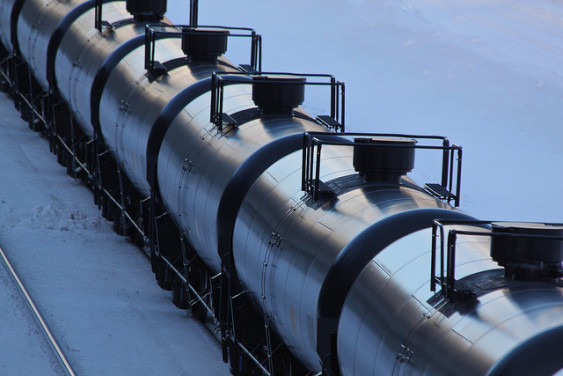One of the biggest players in oil by rail is trying to build more capacity in Washington State. Tesoro, an oil company with a checkered past, already receives loaded crude oil trains at its Anacortes refinery. Now the firm aims to build North America’s largest oil train unloading facility on the banks of the Columbia River in Vancouver, Washington. In an attempt to tamp down the local community’s concern about the catastrophic fires that plague oil train derailments, Tesoro showcased a new addition to its rail car fleet at the Port in September 2015, pointing out that the model exceeds federal standards.

Empty UTLX tank cars at Essex MT headed from Anacortes, WA’s Tesoro refinery back to ND for more oil. by Roy Luck used under CC BY 2.0
What are DOT-120s?
Tesoro is adding to its crude oil rail car fleet by acquiring 210 new DOT-120 tank cars, a model designed to carry pressurized liquids and gases and hazardous materials. While it is noteworthy that the company is improving its fleet with the type of upgrade the industry has largely resisted, the planned upgrade, when studied in context, is exceedingly minor and will do very little to make the proposed Vancouver Energy project safer.
Tesoro’s move was prompted in part by new federal regulations that require railroads to phase out or retrofit the highly unsafe DOT-111 tank car by May 2023 for most uses of crude oil transportation. The announcement came about a year after the company committed to use only CPC-1232 cars for crude oil service, a slightly enhanced DOT-111 that the National Transportation Safety Board deemed “not satisfactory” for the transport of crude oil and ethanol. The CPC-1232 must be phased out or retrofitted in most cases by May 2025.
How many DOT-120s will Tesoro use?
Tesoro’s move seems like a step toward compliance with the new federal regulation, but the number of these new rail cars is very small relative to the scale of its oil transport ambitions. In fact, the new tank cars Tesoro boasts about acquiring are barely enough to fill out two unit oil trains when the company is planning to build enough capacity to handle four or five unit trains per day at its Vancouver terminal alone.
Given that a roundtrip journey from the Bakken oil fields to Northwest ports takes roughly a week, Vancouver could expect to see these enhanced rail cars compose, at most, just 6 or 7 percent of the oil-by-rail fleet arriving in town. And that assumes that all the new DOT-120s would be devoted to serving the yet-to-be-built Vancouver terminal and none of Tesoro’s other refineries, such as the one in Anacortes. Taking both terminals into account, a minimum of 94 percent of Tesoro’s oil-by-rail cars traveling through Washington would be the unsafe CPC-1232 car, potentially for another decade.
How safe are DOT-120s?
#VanWA could expect to see these enhanced rail cars compose just 6%-7% of the oil-by-rail fleet arriving in town.
The DOT-120 is one of five pressure tank cars that are approved to transport hazardous or dangerous materials, including materials that pose a poison inhalation hazard. Otherwise, not much is known about Tesoro’s new rail car. Although the DOT-120 has been around for decades, it has always been a relatively uncommon rail car, and with this rarity comes a lack of data. In fact, Sightline could find no safety tests or accident data on the DOT-120 model. Even Union Tank Car Company, the manufacturer that Tesoro partnered with for its DOT-120s, does not list the DOT-120 among the tank cars it manufactures, although it does list several different models of the more common pressure tank cars. When Sightline contacted Tesoro, the company declined to provide any safety studies supporting the choice of the DOT-120.
In some ways, the lack of available data may actually be a selling point for Tesoro given that their CPC-1232 cars were revealed to be a barely improved version of the old DOT-111. Just three months after Tesoro’s May 2014 announcement that it would exclusively use CPC-1232 tank cars for oil transportation, an oil train made up of CPC-1232 cars derailed in Lynchburg, Virginia, spilling over 23,000 gallons of oil into the James River. Several of the cars erupted into a towering inferno not far from a busy restaurant and a children’s museum.
The known facts about DOT-120s suggest these cars are superior to the rest of Tesoro’s fleet, but there is still cause for concern. For example, the outer steel shell of Tesoro’s new tank cars would be 9/16 of an inch, exactly the same thickness as the DOT-117, which federal regulators have shown will puncture with a side impact as slow as 12 mph.
It is useful to compare the DOT-120 to another pressure car, the more common DOT-105. The safety features of the DOT-105s tested in accident analysis scenarios—puncture-resistant shields at the ends of the tank cars, higher test pressure, fire-resistant thermal insulation—actually match or exceed those of the DOT-120. The Federal Railroad Administration and Transport Canada’s Next Generation Rail Car Project tested a DOT-105 pressure car with a 0.777-inch shell thickness—38 percent thicker than the 0.563-inch shell of Tesoro’s DOT-120—and found that the cars rupture upon an impact of 15 mph. The Project’s tests on various pressure car tank heads (the ends of the rail car) found that an impact of 18 mph punctures the protective head shield and will fracture tank heads much thicker than Tesoro’s model.
Given what we know about comparable rail cars with a shell thickness equal or greater to the DOT-120, it’s reasonable to conclude that Tesoro’s new cars could rupture from a side impact between 12 mph and 15 mph, or a head impact of less than 18 mph. It’s not just a theoretical point: when a DOT-105 car with a 30 percent thicker shell and 25 percent thicker tank head than Tesoro’s DOT-120 ruptured in a 2005 train derailment in South Carolina, the escaping chlorine gas killed nine people and hospitalized 75 more.
Tesoro’s fleet changes, while a step in the right direction, are inadequate to the task of making its Vancouver, Washington, oil train terminal safe. Although the new DOT-120 tank cars are better designed than the other rail cars in Tesoro’s fleet, they would still rupture at slow speeds and could spill their contents with even modest impacts. Plus, they would compose a very small percentage of Tesoro’s oil train traffic in the Northwest, rendering the upgrade, in short, much ado about next to nothing.
Click here for another close look at the many flaws of improved oil trains.










Comments